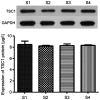Correlation between TSC1 gene polymorphism and epilepsy
- PMID: 29285181
- PMCID: PMC5740816
- DOI: 10.3892/etm.2017.5345
Correlation between TSC1 gene polymorphism and epilepsy
Abstract
The correlation between tuberous sclerosis complex 1 (TSC1) gene polymorphism and epilepsy was studied. In total, 38 patients with epilepsy treated in People's Hospital of Rizhao from May 2015 to June 2016 were selected as study subjects, as the observation group, 38 healthy people in the same period were selected as the control group. Polymerase chain reaction-restriction fragment length polymorphism (PCR-RFLP) was used to study the polymorphism of TSC1 gene in the above study subjects. The mRNA expression of TSC1 gene in the observation group and the control group was measured by fluorescence quantitative PCR, the expression of TSC1 protein in the control and observation group was measured by western blotting and ELISA. The polymorphisms of TSC1 gene in control group and observation group were analyzed by PCR-RFLP. There were three genotypes of TCS1 gene locus 142 in healthy population: CC (79.3%), CA (13.9%) and AA (6.8%), there were also three genotypes at locus 142 in the observation group: CC (21.3%), CA (26.4%) and AA (52.3%), there was significant difference in the genotypes at locus 142 between healthy population and the patients with epilepsy (P<0.05). It was observed by fluorescence quantitative PCR that there was no significant difference in the mRNA expression of TSC1 gene between the control group and the observation group (P>0.05). The expression of TSC1 gene was detected by western blot method. Western blotting showed no significant difference in TSC1 protein expression between the two groups (P>0.05). However, by determining the activity of TSC1 protein in the observation group and the control group by ELISA, it was found that TSC1 activity in healthy human body (8.95±2.41 U/ml) was much lower than that in the patients with epilepsy (29.27±4.06 U/ml), the difference was statistically significant (P<0.05). It was found that locus 142 may be located at the active center of TSC1 enzyme by homology modeling of SWISS-MODEL, the mutation of locus 142 could lead to the change of TSC1 activity. The polymorphism of locus 142 in TSC1 gene is correlated with epilepsy, that is, the increase of CA and AA content in locus 142 leads to the occurrence of epilepsy.
Keywords: SWISS-MODEL; epilepsy; gene polymorphism; homology modeling; tuberous sclerosis complex 1.
Figures






Similar articles
-
Research on the correlation between the polymorphism of the back-2 gene and osteoarthritis.Eur Rev Med Pharmacol Sci. 2018 Jul;22(1 Suppl):76-82. doi: 10.26355/eurrev_201807_15367. Eur Rev Med Pharmacol Sci. 2018. PMID: 30004558
-
Tuberous sclerosis-like lesions in epileptogenic human neocortex lack allelic loss at the TSC1 and TSC2 regions.Acta Neuropathol. 1997 Jan;93(1):93-6. doi: 10.1007/s004010050587. Acta Neuropathol. 1997. PMID: 9006662
-
[Correlation of gene polymorphism of interleukin 4 receptor alpha peptide chain and total serum IgE levels in asthmatic children in Guiyang area].Zhonghua Yi Xue Za Zhi. 2014 Sep 30;94(36):2822-7. Zhonghua Yi Xue Za Zhi. 2014. PMID: 25534099 Chinese.
-
Study on the correlation between KCNJ11 gene polymorphism and metabolic syndrome in the elderly.Exp Ther Med. 2017 Sep;14(3):2031-2035. doi: 10.3892/etm.2017.4714. Epub 2017 Jun 30. Exp Ther Med. 2017. PMID: 28962121 Free PMC article.
-
Comprehensive mutation analysis of TSC1 and TSC2-and phenotypic correlations in 150 families with tuberous sclerosis.Am J Hum Genet. 1999 May;64(5):1305-15. doi: 10.1086/302381. Am J Hum Genet. 1999. PMID: 10205261 Free PMC article. Review.
Cited by
-
Neurodegenerative pathways as targets for acquired epilepsy therapy development.Epilepsia Open. 2020 Mar 12;5(2):138-154. doi: 10.1002/epi4.12386. eCollection 2020 Jun. Epilepsia Open. 2020. PMID: 32524040 Free PMC article. Review.
References
LinkOut - more resources
Full Text Sources
Other Literature Sources
